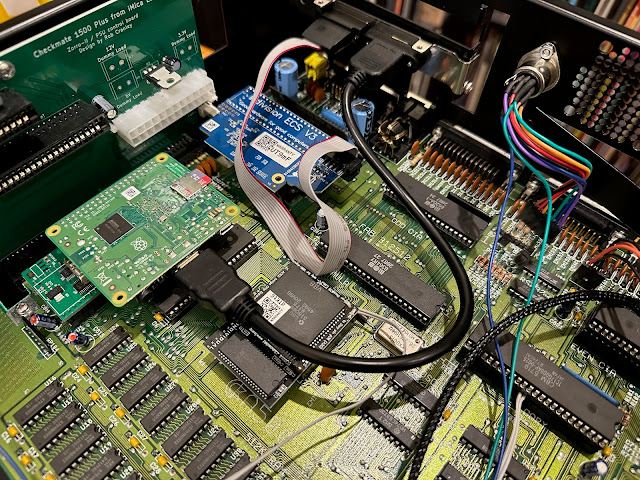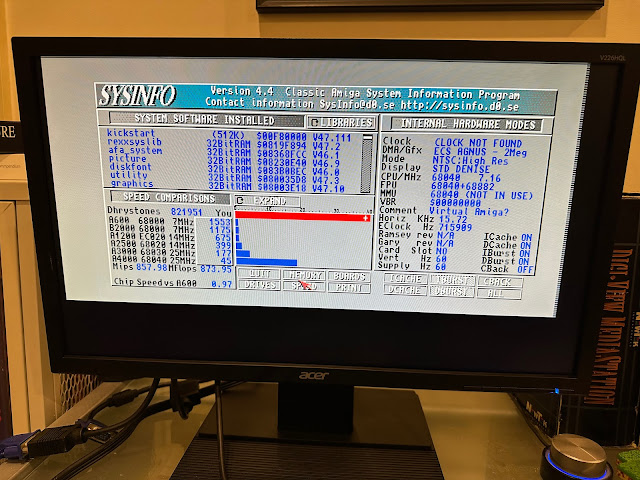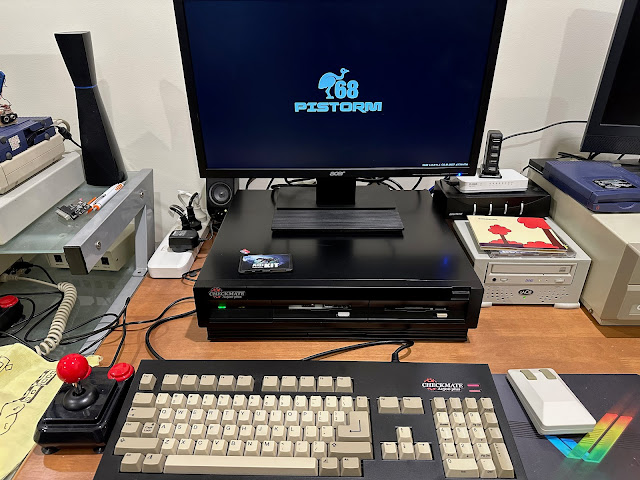Amiga 500 with AmiKit 12 Pistorm, new games and Checkmate 1500 plus
Way back in June this year, I setup an Amiga 500 to use the original Commodore A590 and A570 CD drives, with other upgrades as well. You can see that post here.
Why is that relevant? Well, at that time I pulled apart my Checkmate 1500 Plus case with an Amiga 500 motherboard and Pistorm upgrade to use for that, leaving the Checkmate case without a computer, and also without a Pistorm setup anymore.

Problem was, I didn't have another Amiga 500 board I could use for this.
As fate would have it, I attended the Perth Amiga User Group meeting around the same time, and entered a raffle for an Amiga 500. To my surprise, I won the raffle, and got myself an Amiga 500 to use for this project!
I put it carefully into my suitcase for the flight home, and fired it up and confirmed it worked - and I am glad to say it did!
This Amiga 500 had a Kickstart 1.2 rom in it, and no upgrades at all. Totally vanilla:
This made it the perfect machine to use for re-building my Pistorm setup in the Checkmate 1500 Plus case, so I could try out the new AmiKit Pistorm!
This game is not a great game, but it was the very first game I bought for my Amiga using my own money - it was a $5 bargain bin special I got at Bruining Headlam computers in Perth, as I lived there back then. Seems appropriate to use it for testing this Amiga 500 I got from Perth!
I don't need to worry about routing the cables, since this will be removed entirely from this case to be put into the Checkmate 1500 plus case.
This pi 3A has been using an old Pistorm distribution from when I originally setup the Pistorm in 2021, which is very different to the Emu68 distribution used on modern Pistorm setups, including the AmiKit 12 Pistorm distribution.
This requires me to remove the Gary chip, and put the connector to the ACE2 on the Gary chip socket, then put the Gary chip back on top.
Here is the ACE2 other part, which has required me to remove the Buster chip and replace it with the main ACE2 board, which has it's own buster chip on top.
I lastly add the DF0 selector hardware (bought from Amigastore.eu) onto the CIA chip, allowing me to switch DF0 in hardware between the internal floppy drive and the external one.
In reality the external floppy drive is routed internally on the Checkmate 1500 plus to an internal gotek, which allows me to boot df0 from real floppy disks on the internal drive, or from ADF files on the gotek. Very convenient to have it all hosted within the Checkmate 1500 plus case. You can see this more later on.
I then got the checkmate 1500 plus case out of the cupboard where it has been neglected for the past 6 months, so it can be used again:
I removed and attached the Zorro board redirector and power module from the checkmate case and attached it to the Zorro slot on the left side of the A500 board. The reason for this is because it is not possible to connect it with the board fixed inside of the case.
I then connected the external floppy connector to the internal gotek using my funky floppy cable, which uses an external floppy cable for an external drive (which was dead), which I route internally to connect to the gotek floppy cable :-)
I plugged in the keyboard cables to the external port that connects to the Checkmate 1500 keyboard housing (which houses the original Amiga 500 keyboard in it).


The extra height of the adapter unfortunately causes a small issue for the Pi, which is now too low to sit flat over the top of the kickstart chip.
The HDMI cable does a great job of spacing the Pi from the kickstart rom chip, which while not looking great, works fine.
I then put the power cables into the zorro board plus power board module, which sits just above the Pi:
I also plan to try out getting my older Amiga 2000 A2091 SCSI card working with this setup too, given the checkmate 1500 plus case has a Zorro slot for such a purpose with a spare slot.
I turned off the memory on it using the onboard jumpers to avoid conflicts with the Pistorm. I plan to use it with my external SCSI CDROM drive.
Close up showing the external DB25 SCSI port of the A2091 card, with the HDMI output from the Pi, and the VGA scan doubled output from the native video using the Indivision ECS v3.
Before playing with the AmiKit Pistorm, I fired up the computer with the older Pistorm setup, since I know it was working, and sure enough, the system booted up first time and everything works - fantastic!
I used the space in front of the Amiga 1000 to setup initially, as it has more room in front. I needed a TFT screen with VGA and DVI inputs to feed both video outputs to the same screen. I then used a HDMI to DVI cable to connect the pi to it.
There are a few steps to follow to get the system up and running, since the AmigaOS 3.2 roms, AmigaOS 3.2 software and some copyrighted software like Roadshow needs to be purchased separately and copied to the Boot partition on the MicroSD card. This can be read from your PC, Mac or linux box, so it is easy enough to copy the files needed.
AmiKit Pistorm presents the same installation process screens as other AmiKit releases for Windows, Mac, Linux, Pi, etc. It is great to be able to run this on real Amiga systems finally.
In the past I have run AmiKit Real on my Amiga 4000T and A1200 systems, but it is a bit slow and I replaced it with AmigaOS 3.2 this year. Having the Pistorm allows the full featured AmiKit to run at normal speed on a real Amiga.
The installation proceeds, copying across the needed files from the various adf and archives I placed on the Boot partition earlier:
The copy takes longer than it does when running AmiKit as an emulation on Mac or Windows, but that should be expected since it is using real Amiga hardware now.
This is a great shoot em up, the graphics and music are wonderful, and definitely recommended. The move from horizontal to vertical really works for this game.
I also tried out the preview of Dread, the amazing doom clone on my other Amiga 500 system. Doom on a stock Amiga 500 - who would have thought it would ever be possible, and yet here it is in 2023:
How amazing would this have been in 1994 to show Dread to the people who converted to PC that a Amiga 500 could do Doom after all!
I also tried out Minky, a very pretty new platform game released for Amiga in 2023:
The CD works on Amiga CD32, you can install to hard disk, and you can also play from floppy disks - the disk labels were included, so I wrote out the ADF images to disk to try out:
This game is quite the looker, it's a nice isometric 3d adventure game, and I look forward to playing the final game when it is released in early 2024!
Anyway, distractions need to end as the AmiKit Pistorm installation has completed successfully, and is ready to choose a screen mode:
Now at this point it reminds me to select the network drivers for internet access, needed to download updates and register this installation.
I have this rather nice looking A565 version of the Plipbox I bought a few years ago alongside a number of other upgrades:
I then connected a MicroUSB cable to power the Plipbox, as there is not enough power to power it from the internal port alone.
I stepped through the wizard to configure the network using the Plipbox - I selected the LAN card and then the Plipbox. Sorry for the crappy iPhone screen photos but it was all I had time for:
A message warning about the plipbox not working sometimes is a good warning - in my experience soft resets mean the plipbox doesn't work on the reboot. Power off/on is needed.
I selected to use internet time to sync the time for this Amiga, since I have no RTC on the Amiga 500.
On bootup, this Emu68 Pistorm logo appears, which is quite cool. Version info is shown in the bottom right corner. As mentioned it is running v1 RC1 firmware initially - I upgraded it to RC2 later.
After booting into AmiKit Pistorm, the updates screen appears, allowing me to enter my purchase ID and email information to activate my copy of AmiKit 12 Pistorm and apply the latest updates, which require a paid subscription.
On the Plipbox I found I needed to do it twice before the update downloaded successfully. This mirrors similar experience for AmiKit on Windows, Mac, Linux if there is a lot of network activity when the download occurs.
With the 12.3 update applied, the system boots up into the full AmiKit 12 Pistorm environment. It looks sensational:
If you have used AmiKit XE 12 on Windows, linux or Mac, then most things work the same on the real Amiga hardware, with the exception of Rabbit Hole, which works a little differently.
For those who care about such things, here is the obligatory SysInfo benchmark performance screen - needless to say with the Pistorm, system performance is incredible:
Kinda funny to see Zorro III devices on a Amiga that never supported Zorro III originally...2023 removes the boundaries!
Looking at the memory in the system, I have 236MB FAST memory (Zorro III I guess), and an extra 112MB fast memory (Zorro II I presume) installed via the Pi. 348MB fast memory - nice!
This is one seriously upgraded Amiga 500! I moved it into its new home next to my Amiga 2000. I moved the Amiga 4000D that was there - not sure where it will go yet. Once problem at a time.
I put it here because I have an external SCSI CDROM drive (normally connected to the A2000), that I wanted to test connecting to the A2091 card on the Pistorm.
I connected my new joystick, and wireless Tank Mouse to the system also. With that done, the AmiKit Pistorm setup is now looking very nice indeed:
With the joystick hooked up, time to try some games included with the AmiKit 12 Pistorm, starting with Open Tyrian - which works brilliantly:
I should caution people that Pistorm is still beta, and there is a lot of development still ongoing to improve its compatibility with original Amiga games and demos. I found in testing a number of demos ran too fast or glitchy, similar to what I found last time I tested a Pistorm setup.
To be honest, I think the Vampire v2 compatibility is much better than Pistorm, but then again, Vampire is a lot more expensive than the Pistorm solution.
My late father loved this game and played it to the end, and also finished Diablo II and III. Sad he never got to try the recently released Diablo IV - I think he would have loved it. Anyway, definite memories for me reliving this game, and glad to do it on the Amiga 500 for the first time!
As mentioned earlier, I then took out the MicroSD card from the Pi in the Amiga 500, put it in my Alienware PC to download and then transfer the updated RC2 files from emu68 GitHub to the boot partition on the MicroSD.
I also copied all my whdload games, demos, modules and more on the Alienware PC while I was updating the firmware files on the MicroSD. There is a 10GB FAT partition on the MicroSD for this, which is readable on the Amiga as well.
That done, I could then set one of favourite backgrounds for the workbench, which nicely personalises my AmiKit 12 Pistorm setup.
There is more still to do - I want to get some demos from the Vampire CF card onto this system, since they use RTG and should work on this system too - I also want to put some CD based games on here, which I need to get working also.








































































































